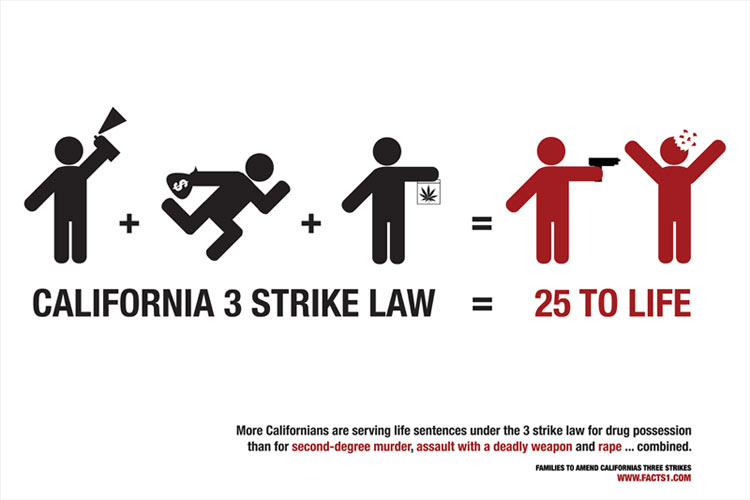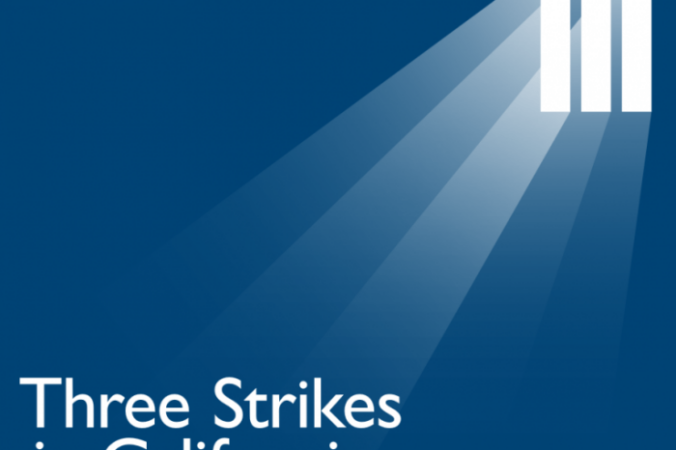
- What is the Three Strikes Law?
- Key Elements of the Three Strikes Law
- Arguments for the Three Strikes Law
- Arguments Against the Three Strikes Law: What Is The Three Strikes Law
- Impact of the Three Strikes Law
- Alternatives to the Three Strikes Law
- Current Status of the Three Strikes Law
- Last Recap
- Key Questions Answered
What is the Three Strikes Law? This policy, implemented in various jurisdictions, has sparked heated debates about its effectiveness and its impact on the justice system. At its core, the Three Strikes Law seeks to deter repeat offenders by imposing harsher penalties for subsequent criminal offenses. The origins of this law can be traced back to the 1990s, fueled by public anxieties about rising crime rates and a desire for stricter punishment.
The law typically defines a “strike” as a serious felony conviction. Upon a third strike, even for relatively minor offenses, offenders often face lengthy prison sentences, sometimes even life imprisonment. While proponents argue that the Three Strikes Law has effectively reduced crime rates and provided a sense of security for communities, critics contend that it leads to over-incarceration, disproportionately affects marginalized communities, and imposes significant financial burdens on taxpayers.
What is the Three Strikes Law?

The Three Strikes Law is a criminal justice policy that imposes harsher sentences on repeat offenders, particularly those convicted of violent felonies. This law has been implemented in various forms across the United States, aiming to deter crime and protect society.
Origins of the Three Strikes Law
The Three Strikes Law emerged in the 1990s as part of a broader “tough on crime” movement in the United States. The law was initially proposed in California in 1993, and its popularity grew rapidly following several high-profile violent crimes. The public demanded stricter penalties for repeat offenders, and the Three Strikes Law became a symbol of this demand.
Core Principles of the Three Strikes Law
The Three Strikes Law is characterized by its emphasis on imposing substantial prison sentences for repeat offenders. The core principles of the law can be summarized as follows:
- Three Strikes Rule: This principle dictates that individuals convicted of three or more serious felonies, often referred to as “strikes,” face significantly longer prison sentences, often including life imprisonment without the possibility of parole.
- Mandatory Sentencing: The Three Strikes Law typically mandates that judges impose specific minimum sentences for qualifying offenses. This reduces judicial discretion and ensures that repeat offenders receive harsh penalties.
- Focus on Violent Crimes: While the exact definition of a “strike” varies by state, the Three Strikes Law generally focuses on violent crimes, such as murder, rape, robbery, and assault. This emphasis reflects the public’s concern about violent crime and the desire to protect society.
Key Elements of the Three Strikes Law
The Three Strikes Law, a controversial criminal justice policy, has been implemented in various forms across the United States. Its core purpose is to impose stricter penalties on repeat offenders, particularly those convicted of serious crimes. This law aims to enhance public safety by deterring repeat offenses and ensuring longer prison sentences for habitual criminals.
Types of Crimes
The Three Strikes Law typically applies to a range of offenses, with varying degrees of severity. These offenses are categorized into three tiers:
- Violent Felonies: These offenses include murder, rape, kidnapping, robbery, arson, and assault with a deadly weapon. These crimes are considered the most serious and often trigger the most severe penalties under the Three Strikes Law.
- Serious Felonies: This category encompasses a broader range of offenses, such as drug trafficking, burglary, grand theft, and certain white-collar crimes. These offenses are less severe than violent felonies but still carry significant penalties.
- Less Serious Felonies: This tier includes offenses that are generally considered less serious, such as possession of a controlled substance, petty theft, and driving under the influence. While these offenses may not trigger the harshest penalties under the Three Strikes Law, they can still contribute to the accumulation of strikes.
Concept of Strikes
The “strikes” in the Three Strikes Law refer to prior felony convictions. Each felony conviction constitutes a strike, and the number of strikes accumulated determines the severity of the sentence for subsequent offenses.
- First Strike: A first strike usually results in a standard sentence for the current offense.
- Second Strike: A second strike, usually involving a serious or violent felony, typically leads to a longer sentence than the standard sentence for the current offense.
- Third Strike: The third strike, often involving a serious or violent felony, triggers a mandatory sentence, usually a life sentence without the possibility of parole. This is the most severe consequence of the Three Strikes Law.
Sentencing Implications
The Three Strikes Law significantly impacts sentencing for repeat offenders. The most notable feature is the mandatory life sentence for individuals convicted of a third strike, even if the third strike is a relatively minor offense.
“The Three Strikes Law mandates a life sentence without the possibility of parole for a third strike conviction, regardless of the nature of the third strike offense.”
This law has led to lengthy prison sentences for individuals with prior felony convictions, even for relatively minor offenses. For example, a person convicted of petty theft as a third strike could face a life sentence, even if their prior convictions were for non-violent offenses.
The Three Strikes Law has been subject to both praise and criticism. Supporters argue that it effectively deters repeat offenses and protects public safety. Critics contend that it is overly harsh, disproportionately impacts minorities and low-income individuals, and leads to overcrowded prisons. The law’s impact on sentencing and its broader implications on the criminal justice system continue to be debated.
Arguments for the Three Strikes Law

The Three Strikes Law has been a subject of intense debate, with proponents arguing for its effectiveness in deterring crime and protecting public safety. They believe that the law’s strict sentencing guidelines send a clear message to potential offenders and ensure that repeat offenders face significant consequences for their actions.
Deterrence
Proponents of the Three Strikes Law argue that its harsh penalties serve as a powerful deterrent to criminal activity. They believe that the prospect of lengthy prison sentences for repeat offenders discourages individuals from engaging in criminal behavior. The law’s emphasis on incapacitation aims to remove repeat offenders from society, reducing their opportunities to commit further crimes. For example, a study by the National Institute of Justice found that states with Three Strikes laws had lower rates of violent crime compared to states without such laws.
Public Safety
The Three Strikes Law is often viewed as a vital tool for enhancing public safety. Proponents argue that by incapacitating repeat offenders, the law protects communities from individuals who pose a significant risk to their well-being. They believe that the law’s focus on protecting the public outweighs any potential concerns about its impact on individual rights. The law’s supporters point to the high recidivism rates among repeat offenders as evidence of the need for strict sentencing measures.
Arguments Against the Three Strikes Law: What Is The Three Strikes Law

The Three Strikes Law, despite its perceived effectiveness in deterring crime, has been subject to considerable criticism. Critics argue that the law is too harsh, disproportionately impacts certain demographics, and carries significant financial and social costs.
Over-incarceration
The Three Strikes Law has been criticized for contributing to the United States’ high incarceration rate, which is the highest in the world. This is because the law mandates lengthy prison sentences, even for non-violent offenses, after a third strike.
- A study by the Sentencing Project found that the Three Strikes Law has led to a significant increase in the number of people incarcerated in the United States, particularly for drug offenses. The study found that the law has disproportionately impacted people of color, who are more likely to be arrested and convicted of drug offenses.
- For example, in California, the Three Strikes Law has been credited with contributing to a 25% increase in the state’s prison population. The law has also been criticized for its impact on the state’s budget, as it has led to increased spending on prisons and law enforcement.
Financial and Social Costs
The Three Strikes Law has also been criticized for its financial and social costs. The law has led to increased spending on prisons and law enforcement, which has strained state budgets. It has also been argued that the law has had a negative impact on families and communities, as it has separated families and deprived communities of valuable members.
- The high cost of incarceration is a significant burden on taxpayers. The Three Strikes Law has contributed to this burden, as it has led to longer prison sentences and an increase in the number of people incarcerated.
- The Three Strikes Law has also been criticized for its impact on families. When a parent is incarcerated, it can have a devastating impact on their children. Children of incarcerated parents are more likely to experience poverty, academic problems, and behavioral problems.
Impact of the Three Strikes Law
The Three Strikes Law, with its focus on repeat offenders, has had a significant impact on the criminal justice system and society. Its implementation has led to various consequences, including changes in prison populations and crime rates. Examining these impacts provides a comprehensive understanding of the law’s effectiveness and its broader societal implications.
Impact on Prison Populations
The Three Strikes Law has dramatically increased prison populations in many states. This is primarily due to the law’s mandatory sentencing guidelines, which often result in lengthy prison terms, even for non-violent offenses. For instance, a study by the Pew Charitable Trusts found that California’s Three Strikes Law contributed to a 70% increase in the state’s prison population between 1994 and 2006. This surge in incarceration has placed significant strain on state budgets, leading to increased costs for prison construction, maintenance, and staffing.
Impact on Crime Rates
The impact of the Three Strikes Law on crime rates is a subject of ongoing debate. Some argue that the law has effectively deterred crime by imposing harsh penalties on repeat offenders. Others contend that the law has had little impact on crime rates, while disproportionately affecting minority communities and contributing to mass incarceration.
“The Three Strikes Law has been a costly experiment in crime control, and the evidence suggests that it has not been effective in reducing crime.” – The Sentencing Project
A 2004 study by the RAND Corporation found that California’s Three Strikes Law had a small but statistically significant impact on reducing crime rates. However, the study also noted that the law’s impact was likely due to the overall decline in crime rates during that period, rather than the law itself.
The effectiveness of the Three Strikes Law in reducing crime remains a complex issue with no definitive answer.
Alternatives to the Three Strikes Law
The Three Strikes Law has been a subject of much debate, with proponents citing its effectiveness in deterring crime and opponents arguing its harshness and disproportionate impact on certain populations. Exploring alternative approaches to crime prevention and punishment can offer a more nuanced and potentially more effective solution.
Rehabilitation Programs
Rehabilitation programs aim to address the underlying causes of criminal behavior and equip individuals with the skills and support necessary to reintegrate into society. These programs can include education, job training, mental health treatment, and substance abuse counseling. The success of rehabilitation programs is crucial in reducing recidivism rates and promoting public safety.
“Rehabilitation programs have been shown to be more effective in reducing recidivism than simply incarcerating individuals.”
- Cognitive Behavioral Therapy (CBT): CBT helps individuals identify and change negative thought patterns and behaviors that contribute to criminal activity.
- Drug Treatment Courts: These courts provide specialized supervision and treatment for individuals with substance abuse issues, helping them address addiction and avoid future offenses.
- Education and Job Training: Providing opportunities for education and job training can help individuals acquire skills that increase their employability and reduce their likelihood of re-offending.
Sentencing Models, What is the three strikes law
Sentencing models determine the length and type of punishment imposed on individuals convicted of crimes. Different models emphasize different goals, such as deterrence, retribution, rehabilitation, and incapacitation.
- Determinate Sentencing: This model prescribes fixed sentences for specific offenses, leaving little room for judicial discretion.
- Indeterminate Sentencing: This model allows for a range of sentences based on factors such as the severity of the crime and the offender’s criminal history.
- Sentencing Guidelines: These guidelines provide judges with a framework for determining appropriate sentences, but they do not mandate specific punishments.
Current Status of the Three Strikes Law
The Three Strikes Law, a controversial criminal justice policy, continues to be a subject of debate and scrutiny. While initially hailed as a tough-on-crime measure, its effectiveness and fairness have been increasingly questioned. Recent years have seen a shift in public opinion and legislative action regarding this law, with several states enacting changes or even repealing it altogether.
Recent Changes and Challenges
The Three Strikes Law has faced numerous challenges and changes in recent years. Some states have amended their laws to reduce the severity of sentencing for certain offenses, particularly non-violent crimes. Others have implemented mechanisms for early release or resentencing for individuals convicted under the Three Strikes Law, recognizing the potential for rehabilitation and the need for a more balanced approach to criminal justice.
- California, the birthplace of the Three Strikes Law, has witnessed significant changes. In 2012, the state passed Proposition 36, which allowed for resentencing for certain non-violent offenses under the law. This amendment was a response to concerns about the law’s disproportionate impact on minorities and its high cost to taxpayers.
- Several other states have also implemented reforms. For example, Washington state passed a law in 2016 that reduced the sentencing range for certain offenses under the Three Strikes Law.
- The debate surrounding the Three Strikes Law is ongoing. Critics argue that the law is too harsh and ineffective, leading to overcrowded prisons and disproportionately affecting minority communities. Supporters contend that it deters crime and protects public safety.
Ongoing Debate
The debate surrounding the Three Strikes Law centers on its effectiveness, fairness, and impact on the criminal justice system. Supporters argue that the law effectively deters crime by imposing severe penalties on repeat offenders, thus protecting public safety. They point to studies that show a decline in crime rates in states with Three Strikes Laws.
- Critics, however, argue that the law is ineffective and costly. They point out that the law often results in lengthy sentences for non-violent offenses, leading to overcrowded prisons and a significant financial burden on taxpayers.
- Moreover, critics argue that the law is unfair. They contend that it disproportionately affects minority communities and that it does not account for individual circumstances or the potential for rehabilitation.
- The debate also revolves around the concept of “three strikes” itself. Some argue that the definition of a “strike” is too broad, encompassing a wide range of offenses, including minor drug possession and petty theft.
Future of the Three Strikes Law
The future of the Three Strikes Law remains uncertain. While some states have implemented reforms, others continue to uphold the law in its original form. The ongoing debate and the changing political landscape suggest that the law will likely continue to be a subject of discussion and potential reform.
- The increasing emphasis on criminal justice reform and the growing recognition of the need for rehabilitation are likely to influence future policy decisions.
- It is possible that more states will follow California’s lead and enact changes to their Three Strikes Laws.
- However, it is also possible that the law will remain in place in some jurisdictions, particularly those with a strong emphasis on law and order.
Last Recap
The Three Strikes Law remains a complex and controversial topic, with passionate arguments on both sides. Its implementation has had a significant impact on prison populations, crime rates, and the overall cost of the criminal justice system. As the debate continues, it’s crucial to consider the law’s effectiveness, its unintended consequences, and the potential for alternative approaches to crime prevention and punishment.
Key Questions Answered
What are some examples of crimes that might trigger the Three Strikes Law?
The specific crimes that qualify as strikes vary by jurisdiction. Common examples include violent felonies like murder, rape, robbery, and assault, as well as serious drug offenses.
How does the Three Strikes Law impact prison populations?
The Three Strikes Law has contributed to a significant increase in prison populations, particularly in states that have implemented it. This has led to overcrowding and strain on prison resources.
Are there any recent changes to the Three Strikes Law?
In recent years, some states have begun to reconsider the Three Strikes Law, making adjustments to its implementation or even repealing it altogether. These changes often reflect concerns about the law’s impact on prison populations and its potential for disproportionate punishment.



